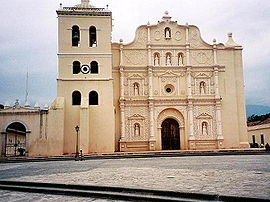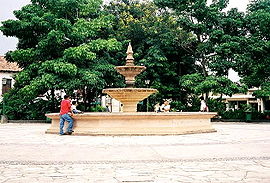Ciudad de Comayagua
| Comayagua | |
|---|---|
|
Coordinates: 14 ° 28 ′ N , 87 ° 39 ′ W
Comayagua on the map of Honduras
|
|
|
Location of Comayagua in Honduras
|
|
| Basic data | |
| Country | Honduras |
| Department | Comayagua |
| City foundation | December 8, 1537 |
| Residents | 60,078 (2005) |
| Detailed data | |
| height | 594 m |
| prefix | +504 |
| Time zone | UTC −6 |
| City Presidency | Carlos Miranda |
| St. Michael Cathedral in Comayagua | |
| Plaza Central de Comayagua | |
| Sand for the eyes of tourists | |
Comayagua is the capital of the Comayagua department in Honduras .
In 2008 there were 87,805 inhabitants.
Geographical location
Comayagua is 37.6 miles north of Tegucigalpa and 77.6 miles south of San Pedro Sula .
history
At the time of the Conquest , Lencas who spoke Lencan lived in this area. The Spanish city was founded on December 8, 1537 as Santa María de Comayagua by Capitán Alonso de Cáceres on behalf of the Adelantado , Governor of Yucatán , Francisco de Montejo, and on behalf of Charles V (HRR) and Santa María de la Concepción , in Taken possession.
Francisco de Montejo described the location as being on the equidistant between the oceans and in the middle of Nicaragua and León (Nicaragua) . Alonso de Cáceres pacified the land of the Higueras or Honduras and found a valley with two rivers, ten legua long and four wide, which was very suitable for founding a city. The Comayagua Valley is fertile land with good pastures, abundant earth fruits, good air and clear skies.
They chose a strategically raised, bare place and applied for possession.
The displaced indigenous people set the Spaniards on fire, delaying the further distribution of their land by two years.
Audiencia de los Confines
With a cédula dated September 3, 1543, Philip II (Spain) instructed the Audiencia de los Confines to be constituted in Comayagua. In the same letter he gave the Ejido the name of Santa María de la Nueva Valladolid de Comayagua to Valladolid , his residence. The part of the city administered by the Cabildo de Españoles was called Concepción de Comayagua .
Thanks to its inland location, protected from pirate attacks, very fertile soils for agriculture and livestock farming and the presence of rich silver mines nearby, the population grew and lived in houses made of Bahareque and brick construction. In 1533 the priest Jerónimo Clemente founded a Mercedarian Convento .
Diocese
In 1550 Truxillo was chosen as the seat of the bishop and the second bishop of Honduras officiated there. In 1551 a stone church was built in Comayagua for 1500 gold pesos. In 1552 the priest Jerónimo de Correll was appointed third bishop of Honduras. The bishopric Truxillo had just been plundered by pirates with letters of misery from England and France. In order not to let his bull of appointment for the diocese of Trujillon expire, he had to take his bishopric in Truxillo, since Comayagua was not a diocese and had no cathedral. The priest Alonso de Guaman asked the Audiencia de Guatemala to move the diocese to Gracias a Dios , where there was a church and a Cabildo de Espanoles. Bishop Pedriza, the first bishop who had his seat in Honduras from 1536, had taken a house as a bishopric. The Audiencia de Guatemala instructed Alonso de Guaman to take his bishopric in Comayagua, which was in the center of the diocese and had a suitable church. The years 1559 and 1562 are given as dates for a possible sanctioning of this relocation.
In 1555, Bishop Jerónimo de Correll of Comayagua made a tour of his diocese and visited Trujillo, Puerto Caballos, San Pedro Sula and Gracias a Dios. In 1560 he traveled to Mexico to be anointed bishop.
In 1564 the only church in Comayagua, that of the Mercedarian Convention, was upgraded to the cathedral of Honduras and Comayagua has since been referred to as a diocese. The royal cédula , which sanctioned this move, was dated 1572. In 1574 the Caja Real , the royal bank, an institute of the Real Hacienda of the Ministry of Finance, was moved from San Pedro Sula to Comayagua. This happened because of the profitable exploitation of the silver mines near Comayagua.
In 1577 Philip II (Spain) upgraded the place to a Ciudad . In 1582 the king inquired whether the church of Comayagua was suitable as a church for a bishopric. Bishop Corrella received 800 ducats from the king, with which he had bricklayers and painters redesign the church of the Mercedarian convent into an episcopal church.
It can be assumed that Bishop Corrella operated the transfer of the bishopric from Comayagua from 1555. A number of reports, dated between 1559 and 1562, were found at the Audiencia de Guatemala , which highlight the merits of Comayagua that can be attributed to this transfer process. In this process the civil, military and ecclesiastical authorities of the Consejo de Indias had to be convinced.
The noticeably long administrative procedure prevented Comayagua from regaining an independent position of power, as was the case at the time of the Audiencia de los Confines . Comayagua was now a nowhere, administered by the Capitanía General del Reyno de Guatemala in the viceroyalty of New Spain .
Comayagua was damaged by earthquakes in 1774 and 1804.
From 1776 Comayagua was the capital of the Intendencia de Comayagua. In 1812, José Gregorio Tinoco de Contreras, as mayor of Comayagua, proclaimed independence from the Spanish motherland. In November 1817, the Consejo de Indias granted the Alcaldía Mayor of Tegucigalpa independence from the Comayagua government, except in defense matters. In 1821, 1822 Comayagua was the capital of the Comayagua province in the Mexican empire of Agustín de Itúrbide , while Tegucigalpa was in opposition to the annexation of Mexico. From 1823 Comayagua was the capital of the Comayagua Province in the Central American Confederation .
From 1823 the seat of the government of Honduras changed between Comayagua and Tegucigalpa.
Comayagua was occupied on May 10, 1827 by troops of the confederation government under Manuel José Arce y Fagoaga , José Dionisio de la Trinidad de Herrera y Díaz del Valle was deposed and arrested.
Then José Francisco Morazán Quezada let fight the troops of the confederation government under Manuel José Arce y Fagoaga and became Supremo Director of the province of Honduras in Comayagua.
Tegucigalpa has been the capital of Honduras since October 30, 1880 under the government of Marco Aurelio Soto.
Attractions
- The patron s feasts are celebrated in the Plaza Central de Comayagua .
- The Palacio de la Alcaldía Municipal was built in the 16th century.
- The Cathedral de Comayagua was consecrated on December 8, 1711.
Hispano Fútbol Club
Comayagua is home to the Hispano Fútbol Club , for which the mayor had a stadium with his name built.
Base Aérea Enrique Soto Cano
15 km south of Comayagua was in Comayaguatal 1982 with three times 20 kilometers of the most extensive air base in Central America, the Palmerola Air Base created. The name is reminiscent of Enrique Soto from New York City , who was proclaimed president during an uprising in Puerto Cortés in April 1897 against Policarpo Bonilla , but what is meant is a pilot from the football war . Approximately 550 US military personnel are called Joint Task Force Bravo and provide 650 civilian workers for humanitarian interventions .
Prison fire
During the fire in Comayagua prison on February 14, 2012 at 10:50 pm local time (5:50 CET on February 15), 356 prisoners were missing and are believed to be dead. 470 prisoners escaped. According to the authorities, an inmate started the fire by lighting a mattress.
Rescue workers could not find keys to cell doors. One inmate reported that over 60 people were in his cell.
The detention center had more than 800 inmates serving medium-length sentences and working in agriculture during the day. It is not a maximum security prison. This fire was the largest prison fire in the world in decades. The prison was designed for 400 people, but occupied 820 people. In Honduras there are a total of 13,000 prisoners in prisons for 8,000.
sons and daughters of the town
- Noel Valladares (* 1977), football goalkeeper
Individual evidence
- ↑ comayagua, Fundación de Comayagua
- ↑ La Prensa , A rescatar la caxa real de Honduras ( page no longer available , search in web archives ) Info: The link was automatically marked as defective. Please check the link according to the instructions and then remove this notice.
- ↑ Asociación para el Fomento de los Estudios Históricos en Centroamérica, TORNOS SANTA CLARA CAGIGAL, Juan Antonio ( page no longer available , search in web archives ) Info: The link was automatically marked as defective. Please check the link according to the instructions and then remove this notice.
- ↑ http://orf.at/stories/2105179/2105155/ Hundreds of prisoners killed in a major fire, ORF.at from February 15, 2012, accessed on February 16, 2012
- ↑ Fire in prison: "We screamed for help, but they didn't open" ( Memento from September 26, 2014 in the Internet Archive )





